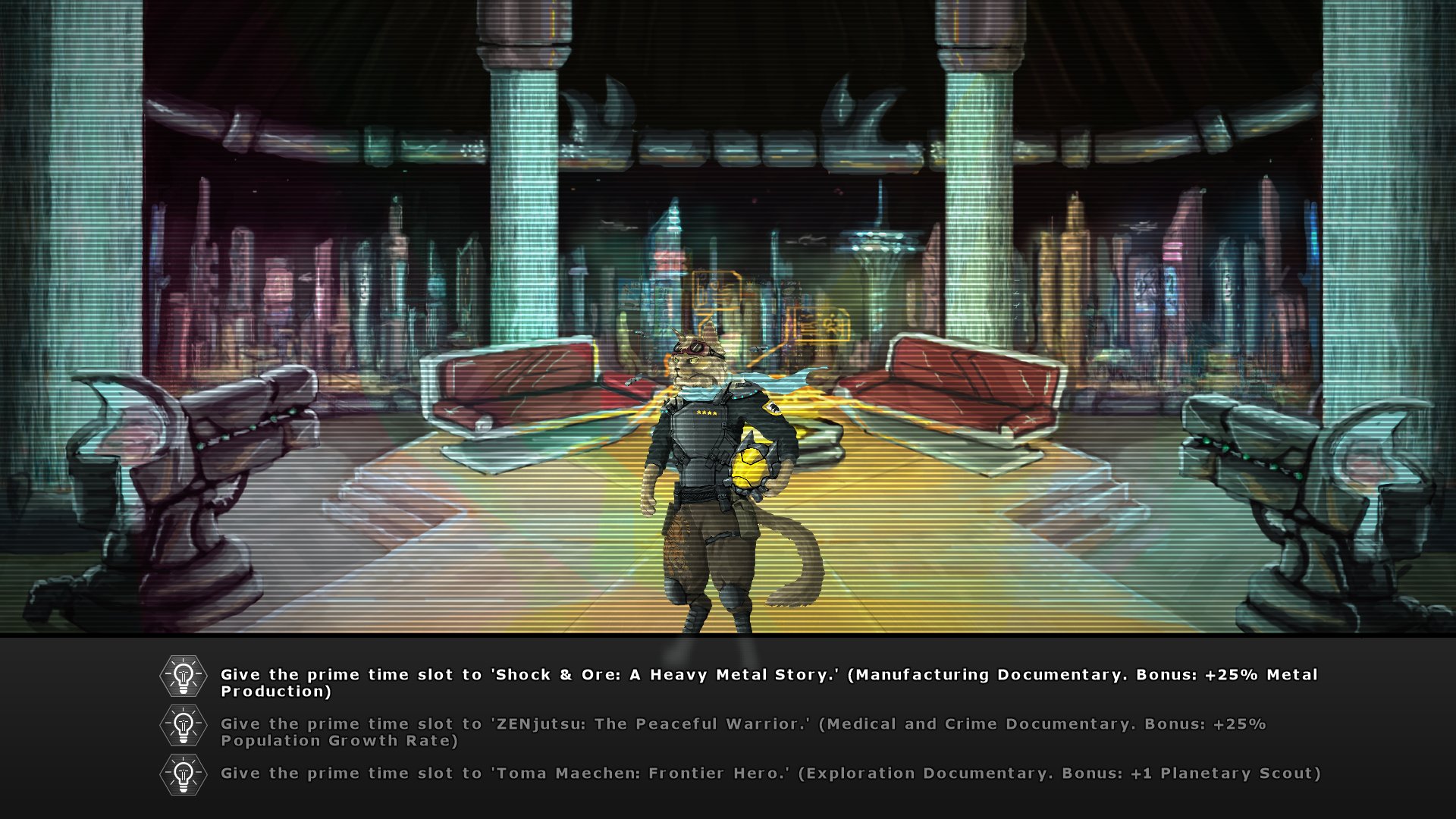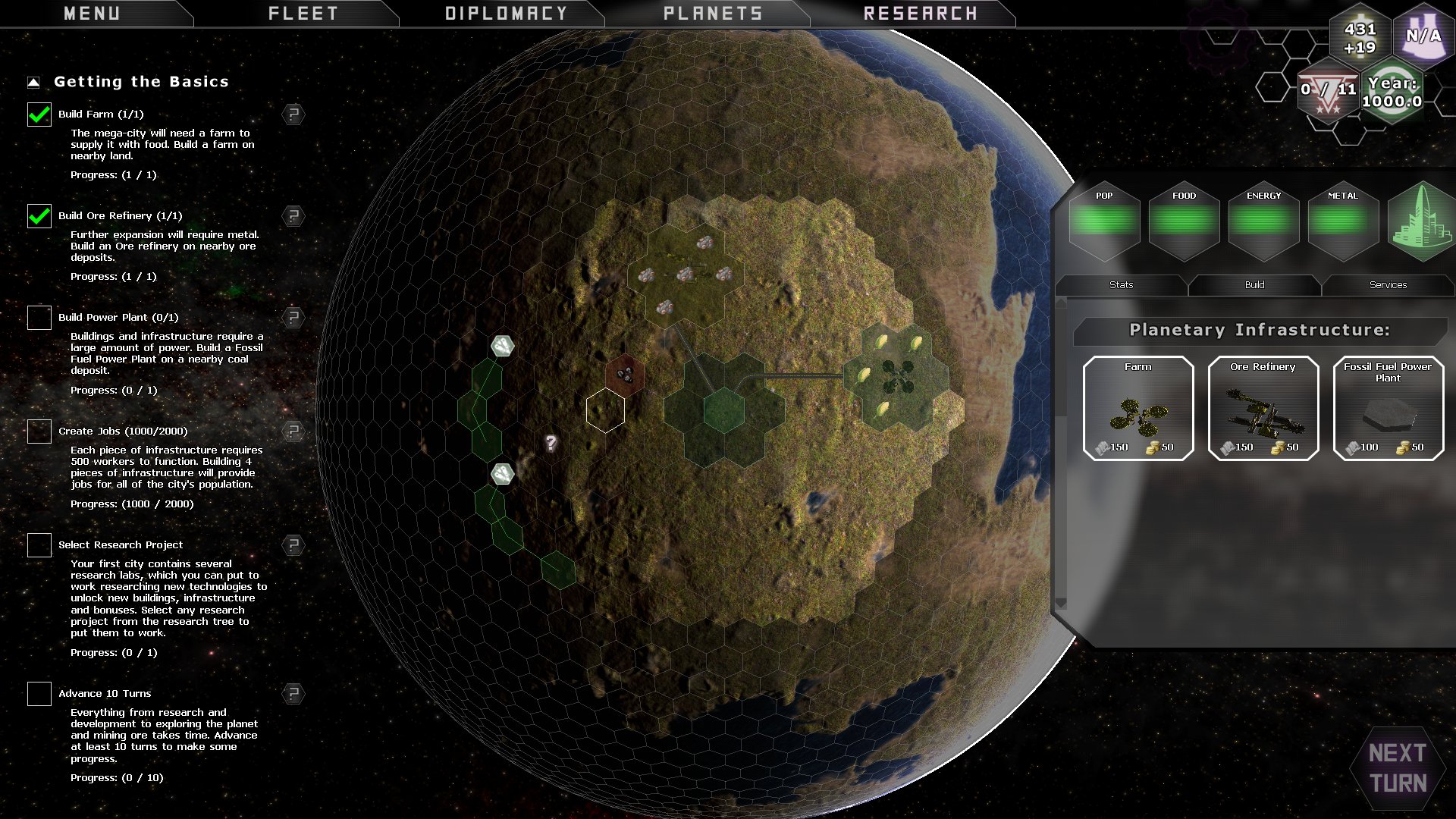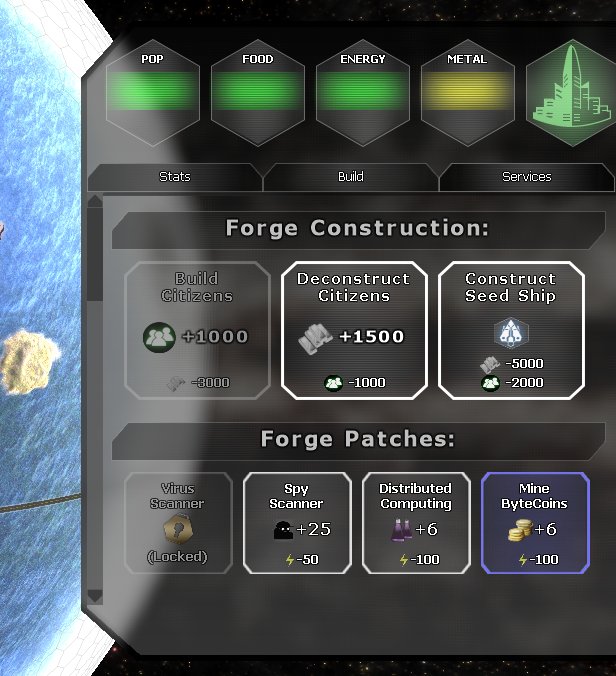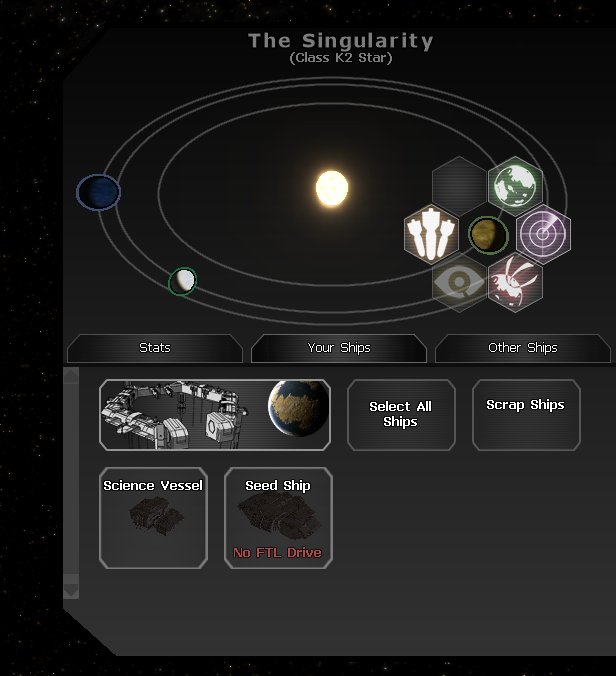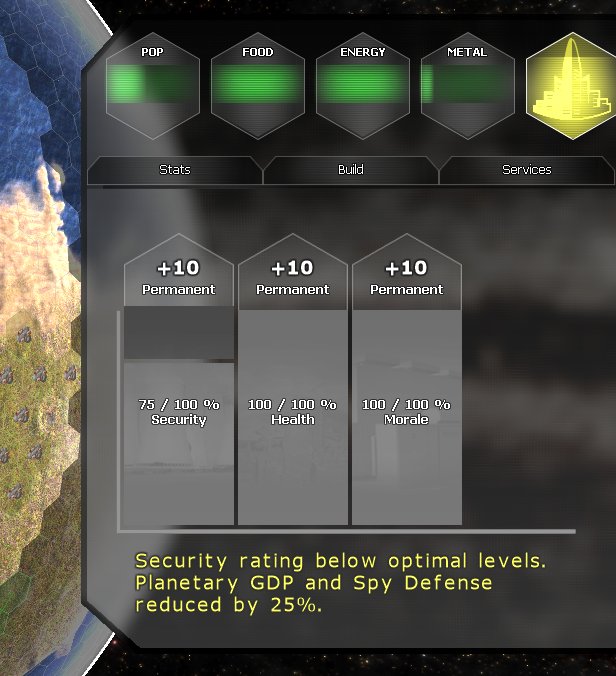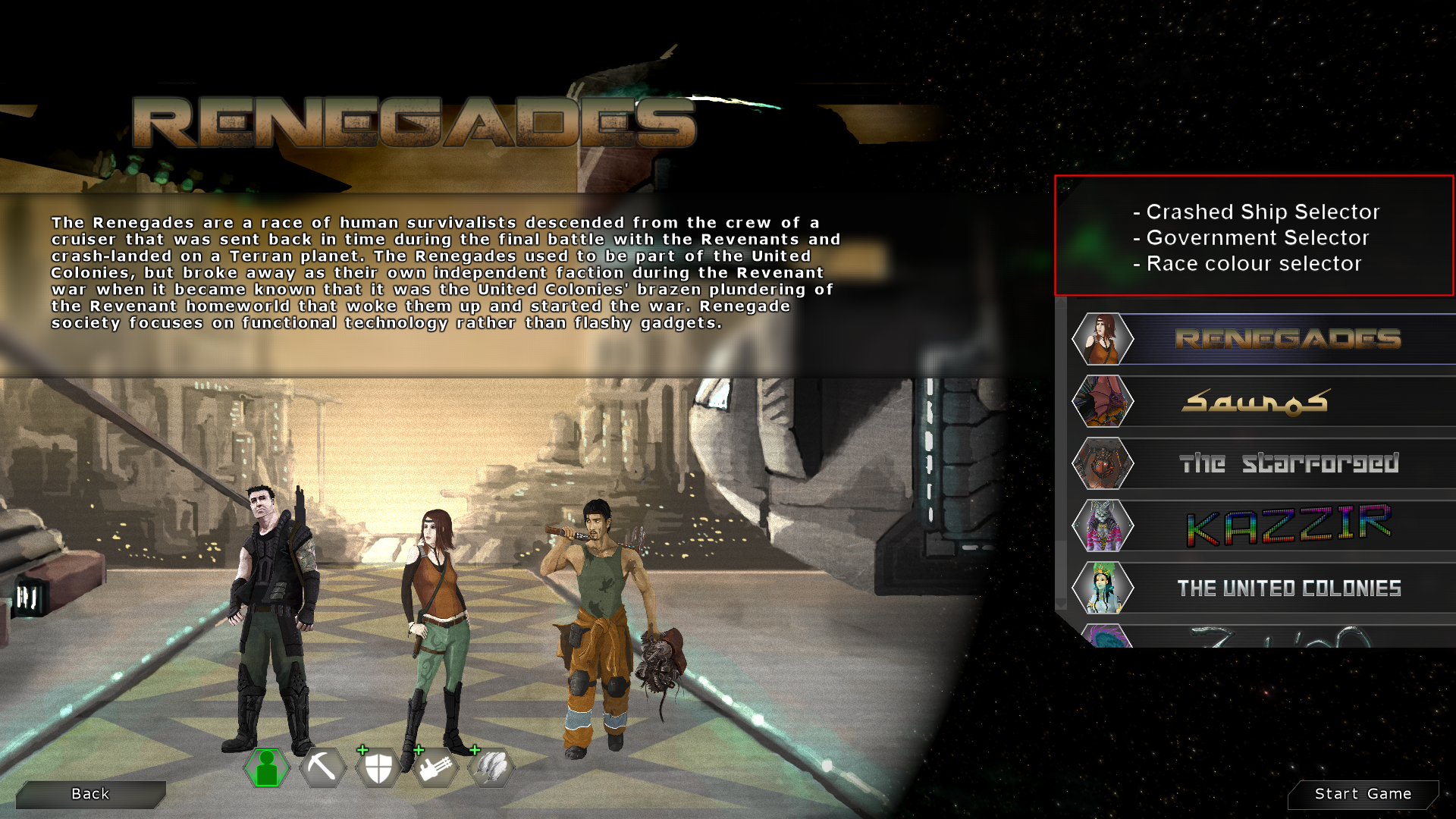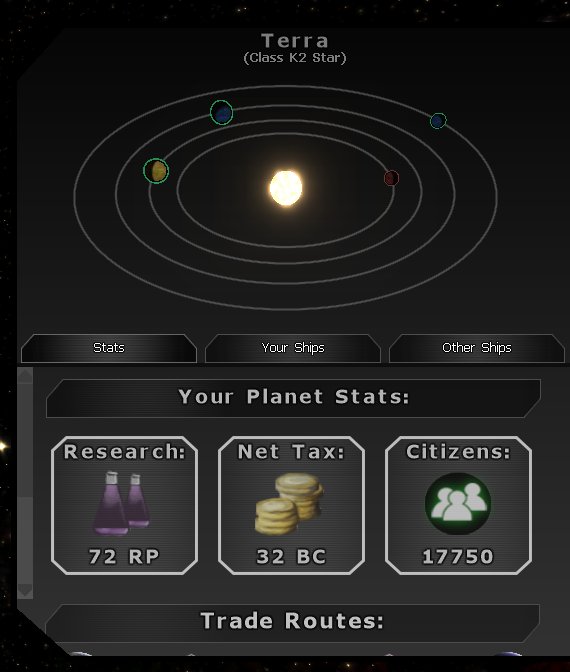We’ve just released V0.9.7.0 and activated the first Singleplayer Mission in the Predestination storyline. You can play this mission after updating your game to 0.9.7.0 by pressing the Singleplayer Mission button on the main menu. In this dev update, we’ll be talking about the Singleplayer Mission system and getting an in-depth look at the mission editing and modding toolset that we’ve built as part of our mission framework. We’ll also discuss the significant improvements to the Robotic race gameplay in this patch, small UI improvements, the Morale/Health/Security V2.0 overhaul, and a slew of other gameplay improvements. Finally, we discuss plans for the next update, which will finish off the remaining dropdown menus, completely overhaul the main menu, add more content throughout the game, and make some much-needed UI improvements.
Read on for a full breakdown and progress report on everything in 0.9.7.0 and details of what’s to come in 0.9.8.0.
Before delving right into this dev update, in order to be 100% transparent and honest with everyone I’d like to briefly discuss a few real life events that recently split our focus. We had originally aimed this patch for release in February (even if it took until the end of February), but it’s been a shockingly bad few months for our small team. Our annual Corporation Tax preparation in January took more preparation work than usual as we applied for the Video Games Tax Credit for the first time. Our office’s back yard then flooded and we had to take a few weeks of dev time out to repair and renovate it as we’re responsible for it as part of our lease. As if that weren’t bad enough, Rufus the Brain and Nerd dog who has been with us throughout all of the game’s development started having medical problems and unfortunately passed away soon after that. In short, it’s been a pretty terrible start to the year for us personally.
We’re persevering though and have been working hard to push forward on the development front, and have now completed and released the Singleplayer Mission update (V0.9.7.0). This update contains the first singleplayer mission and a fully moddable mission framework to help us easily create new missions and help modders in the future. This was the last of the really big features that require a lot of dedicated design and programming time, so the remaining things to be added before V1.0 are mostly missing content, user interfaces, and other small features that should be a lot faster to develop. We’ve also received a small sum from the Video Games Tax Credit so we have the budget to cover the additional development time added and are still on track to finish the game, reach full release, and deliver everything we’ve promised. We’re feeling very optimistic about the future and with every update we’re more pleased with how Predestination is turning out!
.
While the core game mode in Predestination is of course the sandbox mode in which you play the survivors of a ship that was sent back in time and crash-landed on a habitable planet and there are multiple victory conditions, we’re also developing a set of difficult pre-made challenge maps and a full storyline campaign. The entire campaign has been designed and roughly written up, and is split into main two story arcs:
- The pre-disaster arc: This story arc happens before the Revenant war and depicts the events leading up to the temporal disaster. Each race will get one mission tell the story of how it reached space, interstellar colonisation, and diplomatic contact with other races. This is a progressive story, so some of your choices such as how you choose to interact with the other races will have an impact on further chapters. These missions will also start off very easy and act as a kind of story-based tutorial for players unfamiliar with the game or to show players the differences between humanoid gameplay and aquatic or robotic gameplay. The missions get progressively more advanced and difficult as the story progresses. It’s not exactly a spoiler to tell you that this arc eventually culminates in a final battle with the Revenants and ships from each race being sent back in time.
- The post-disaster arc: This story arc deal with what happens to each of the races after being sent back in time. There will be one mission for each race again telling the story of how they re-establish their empires and their conflicting views on how to deal with the Revenants in the past. This will be another progressive story arc with branching options, and without spoiling anything I can say that the final mission will conclude the story and set the canonical ending of the game. That doesn’t mean we can’t deliver new story arcs in the future, however, and we plan to have additional story missions for the backer races post-release.
The Kazzir Story: The mission you can play right now is the first mission in the pre-disaster story arc, named The Kazzir Story. It follows the story of the powerful Zaibatsu Entertainment Network corporation using its wealth to explore and industrialise the Kazzir homeworld, the formation of the Kazzir Corporate Directorship, the Kazzir race to space, and their first contact with an alien civilisation. If the Kazzir aren’t your favourite race in Predestination, remember that both story arcs will get one mission for each race so there are more to come after V1.0. This mission is designed to be a simple introduction to the pre-warp gameplay without being as intrusive as the tutorial. It guides the player slowly through the pre-warp phase and uses story to tie all of the gameplay elements together rather than telling you exactly what to do. There’s no failure condition in this mission, but without spoiling anything I can say that your choices toward the end will affect the gameplay in future missions to a degree.
We’re eager to hear any feedback on the mission system or The Kazzir Story. We’ve set up a special thread on the Steam forum for mission feedback or please feel free to leave a comment here or contact me directly via email to brendan@brainandnerd.com with your feedback.
.
Hopefully the Kazzir mission will give you an idea of the kinds of things we can do with our mission system, but it’s really only scratched the surface of what’s possible. The whole mission toolkit has been designed to load information from human-readable flat files where possible so that it’s fully and easily moddable, and we can do some pretty awesome stuff with it. Below is a detailed breakdown of all of the tools we have at our disposal when designing missions, and that will be available to modders:
- The Conversation System: The heart of the mission toolset is the Conversation system, which allows us to write a branching dialogue between two races and pop up options for players to pick. This is a highly adaptable system that shows a diplomacy-like screen using your race and another race in the mission. As you’ll see in the Kazzir mission, we can choose to display the Scientist, Diplomat, Soldier, or all three in any frame, and can give them custom names to create characters. Each scene can alternatively just display an image just like in the intro sequence, so you can use it for cutscenes or showing the player something, or your race showing the other race something.
- The Response System: This lets us present the player with one or more dialogue responses or selectable options at any point a conversation, and it lets us do some awesome things. Selecting an option can unlock a special mission-only technology, for example, so we can assign bonuses or new ship modules or buildings to particular options. Each option can also optionally trigger a victory sequence, or a failure sequence, or another conversation file — this lets us do full branching dialogue as picking an option can tell the game to load the appropriate dialogue file for that option. Responses can also have points attached (though right now you don’t get a points screen to show you how many you got), and they can trigger mission stages so you can have different missions for different responses.
- Mission Objectives: The mission data file lists all of the stages in the current mission, and each stage can be triggered by a particular response in a conversation or by completing another mission. Every stage has a list of objectives, and each objective consists of a condition like having more than 3 Ore Refineries or having fewer than 2 colonised planets. The objectives actually peek into the game variables to find the stats you want so you can specify literally any variable in the game if you know where it is and what’s it’s called, and it can select from lists and arrays. This lets us do pretty much anything we can think of with the mission objectives.
- Objectives can be set up as optional so that you don’t fail the mission if you fail that objective, and they can have special rewards like free technologies and points. You can even make objectives hidden in order to hide secret technologies and bonuses in your mission. They can optionally be given deadlines of a certain number of turns to trigger the condition or you fail the mission, or can also be set up as “survival” objectives where you have to last for a certain number of turns without triggering the condition (e.g. don’t let the energy reserves drop below 4000 in a mission where enemy ships are pummeling your city shields). We’ve also set up a special class in the game code called GameStatistics that we pull information from, so we can do more complicated things for our missions like looking up how much of the homeworld is explored.
- Memory Events: Another major feature we’ve added is the ability to create Memory Events attached to certain dialogue choices. These events are recorded in a file in the same place your save games go, and future missions can look up the list of all the memory events you’ve triggered! This can lead to complex storylines where your decision to help or hinder a race in one mission can lead to consequences in another when you come to play that race. Without spoiling the storyline, I can say that the Kazzir mission uses memory events to remember which option you selected at the end of the mission and we will be using that in a future mission.
- Galaxy Setup: We can specify practically every aspect of the game setup in a text file, from basic galaxy parameters to modifications like disabling wormholes, removing the Revenants, switching the map to 2D, even custom options like changing how frequent temporal rifts are. We can specify which races are in the game and modify the resources on their homeworlds, what crashed ship they start the game with (or None if we want them to start without one), and what type of government and leader they have. We can also specify what seed value to use for the galaxy so every player gets the same version of the galaxy, or tell it to use a random seed for added mission replayability (e.g. in challenge maps).
- Intro Sequence: Before each mission, we can play an intro sequence similar to our game intro sequence or victory sequences. It’s a fully controllable slideshow of images with text, music, custom shader effects, and optional voice narration. We can also optionally skip this and either jump straight to the first mission stage or to a conversation (as we did in the Kazzir mission).
- Unique Technologies: Each mission has a special file containing unique mission-only technologies, and files containing unique buildings, infrastructure, weapons, and ship modules those technologies can use. This is all totally customisable, including the stats of the individual weapons, buildings, and modules. We can also limit the tech tree to any number of eras (for example, the Kazzir mission is limited to only the Pre-warp era), and can modify the tech trees any way we like, even building completely new tech trees for one mission and different trees for each race.
- Unique Ship Designs: You can include your own ship designs and ship parts in a mission, and there’s a mission setup option that will disable all of the standard ship designs so it only uses the ones you supply. This has some great use cases, for example we used this and some new placeholder modules to let the player select between designing a Camera Ship, War Ship, or Ambassador Ship in the Kazzir mission. This could be used for missions where you might want to have new ship designs carrying unique weapons, like a massive death star.
Still to come for Missions:
We’ll be using this system after release to develop both episodic mission arcs discussed above and some special challenge maps. In addition to this, there are a few features that we’ll be adding in the near future that you’ll be glad to know we haven’t forgotten about:
- Main Menu Overhaul: The “Singleplayer Mission” button is just a temporary way for you to test our first prototype mission, you’ll be glad to know this isn’t the final user interface. We’ll be overhauling the entire main menu screen before release, including adding a panel to browse through the singleplayer campaign and easy options for loading any of your save games and toggling various options.
- Points Award Screen: After the Kazzir mission, you’re currently just dropped back to the main menu. In a future update, we’ll be adding a points awarding screen for after you win or lose a mission with a rating for how well you did and a high score chart so you can keep track of your performance.
- Challenge Maps: Special missions not connected to the main story but set up as a unique challenge to overcome. For example, you might be stranded on a single planet with no way to colonise a new world, and you have to survive for 100 turns as the Revenants send wave after wave of ships toward you. The Singleplayer Mission tools give us a way to implement these challenge maps simply and easily, though we’ll probably want to have the Points Award screen and main menu overhaul complete first so you can track your performance in them.
.
In the previous update, we improved the Robotic race gameplay with the addition of some new technologies and game mechanics, but the Robotic tech trees still had several organic-based technologies and some options such as the Forge Services turned out to be extremely micromanagement-heavy. This patch solved these issues by overhauling how the forge services work and adding new options linked to new technologies. There are now three construction options (Construct Citizens, Deconstruct Citizens, and Construct Seed Ship) that can be activated manually, and four toggleable Forge Patches (Virus Scanner, Spy Scanner, Distributed Computing, and Bytecoin Mining) that consume energy per turn to run (only one can be active at a time). We’ve also added some new endgame technologies for the Robotic races, such as a powerful new power plant and food source that requires Toxic planets.
- Forge Construction – Seed Ship: This new forge option constructs a Seed Ship which is unique to robotic races, turning 2,000 population and 5,000 metal into a special colony ship with no faster-than-light drive. This makes it easier for robotic races to colonise other planets in the same star system as an existing colony. The seed ship is also built instantly and doesn’t tie up your shipyard.
- Forge Patch – Virus Scan: +50 security when toggled on. Costs 50 energy/turn to run this program.
- Forge Patch – Spy Scan: +25 spy defense when toggled on. Costs 50 energy/turn to run this program.
- Forge Patch – Mine ByteCoin: +1 BC per 2,000 population when toggled on. Costs 100 energy/turn to run this program.
- Forge Patch – Distributed Computing: +1 RP per 2,000 population when toggled on. Costs 100 energy/turn to run this program.
- Morale changes: Robotic races are now affected by morale bonuses and penalties (such as Propaganda transmitters), but they still can’t be taxed or research the Entertainment Centre. They instead get -10% morale for each city with no Support Center. This makes propaganda transmitters and spies an effective way to throw a robotic race’s morale into disarray, but also means they won’t have major problems with morale unless attacked in this manner.
- Radiogenic Power Plant: A new robotic-only power plant that consists of a modified Gas Harvester which draws in radiogenic particles from the atmosphere of Toxic planets and generates 200MW of power. This is a late-game technology designed to effectively take the limits off power (which is quite limited for Robotic races) and limiting it to Toxic planets means you’ll have to use trade routes to send that power elsewhere.
- Radiogenic Fuel Pellets: This technology unlocks the Radiogenic Fuel Pellet Factory infrastructure, which produces 4000 fuel pellets per turn and can only be built on toxic worlds inhabited by a robotic race. It’s a large modified gas harvester just like the Radiogenic Power Plant and so takes up considerable space on the planet’s surface. This helps take the limits off food production at the endgame, freeing the player from the need for coal and uranium, and makes Toxic worlds a high endgame priority for Robotic races.
- The Cloud: Since it doesn’t make sense for Robotic races to research Android Bodies, we replaced that tech with The Cloud, which allows your citizens to exist within a virtual data cloud and control multiple robotic bodies as needed. This doubles the number of citizens that can be built on all planets across your empire, having the main effect of increasing the money and RP from the Mine Bytecoins and Distributed Computing forge patches.
.
The previous patch overhauled the Health, Security, Morale and Loyalty stats to be more like resources, but feedback on it wasn’t very positive. Players pointed out that it felt quite random and often difficult to manage, and that even a small loss such as -4% health per turn would quickly lead to a low health rating and catastrophic disease outbreaks. We went back and took a long hard look at this system and decided that the previous implementation was better, but that it still needed improvements. We’ve now gone back to the pre-0.9.6.0 version and iterated on that to produce our new system:
- Health Rating: This now shows a rating between 0% and 100% indicating what percentage of your population is covered by health services. Each hospital provides coverage for 2,000 population, so for example a planet with 1 hospital and 4,000 population will have a 50% health rating. Health rating now affects the population growth rate, and disease outbreaks of varying severity start at 75%, 50%, and 25%. Nuclear power plants now reduce the planet’s health coverage by 2,000 population.
- Security Rating: Similar to Health Rating, this now shows what percentage of your population is covered by security services and each police station provides coverage for 2,000 citizens, with disasters being possible once you’re below 75%, 50%, or 25% coverage. Security Rating now affects the planet’s total GDP due to theft, so a planet with a 60% security rating will have a 40% penalty to its taxable economic wealth. Low security rating also makes a planet more vulnerable to spies and less likely to catch spies.
- Morale Rating: Morale is a flat percentage between 0% and 100%. It starts at 100% and is decreased by 10% for every 10% tax rate you set, so a tax rate of 60% will reduce morale on all planets by 60%. Low morale also decreases the combat rating of all cities on the planet by -1 per 1% missing morale, so that 60% morale planet will have a -40 combat rating penalty in all cities. Disasters such as strike action and civil disturbances can happen when below 50% Morale, with more severe disasters at 25%, and at 0% the planet may rebel and try to leave your empire. The Loyalty stat that used to do this has been completely removed.
- Permanent Bonuses: Planets can now acquire permanent planet-wide bonuses or penalties to Health, Security, and Morale from various random event choices. The homeworld starts off with +10 to each and all planets start off with +10 to health and security (providing 2000 citizens worth of coverage) so that your first city is safe (otherwise it would start with 0 security and health).
Related gameplay changes:
- Entertainment Centre: This is now a piece of planetary infrastructure rather than a building inside the city, and has been buffed from +10% morale to +20%. This makes more sense as morale is a planet-wide stat and different sizes of planet have different numbers of cities. You should find it much simpler to balance the morale across all of your planets and maintain a steady tax rate.
- Captured Planet Changes: Captured planets now suffer from a flat -40% morale penalty that you have to deal with, either by building entertainment centres or dropping your global tax rate, to make it so you have to consider the best way to conquer large swathes of space. Occupied planets can also periodically suffer from insurgencies and uprisings using the Disaster system, where rebels can re-capture a city or blow up farms, ore refineries, or a whole city. This threat persists until that race is fully eliminated from the game, at which point they stop.
- Mind Control: This powerful new technology allows the Psionic Flux Phaser to be used in planetary bombardment, immediately mind controlling a city’s population with no resistance and regardless of any ground troops. It also eliminates the -40% morale penalty for conquered planets across your empire. This is a very powerful endgame technology in the Galactic Domination stage of the Sociology tree, and it gives us something to experiment with to consider whether we want to add a Telepathic race trait to the game.
- Spy Mission Changes: The Sabotage Computers spy mission now reduces Security coverage by 8,000 citizens while active, and periodically attempts to shut down farms, refineries, or research labs for 10 turns. The Incite Civil Unrest mission now reduces Morale on the planet by 40% while active, and if the planet drops below 50% morale then it will experience riots and other problems.
- Tax Calculations: Since you now get a flat -10% morale across your empire for every 10% citizen tax, the taxable economic wealth from cities has been reduced to compensate. Players will find that they’re able to keep a much higher rate of tax than they could previously as long as their planets’ morale is balanced. The Tax Office has been re-branded as the Housing Office, which increases economic wealth in the city by 25% but decreases the city’s combat rating by 20 instead of messing with planetary morale. The tax window now gives an orange warning if any planets will have below 100% morale with the selected tax rate, and a red warning if any will have below 50% morale.
- Civilian Government: If you’re careless enough to allow morale to hit zero on a planet, you run the risk that the population will rebel and attempt to leave your empire. This now happens through a new disaster event, and your options include allowing them to leave, pacifying them by force, or granting the planet a civilian government. If you grant a civilian government, the planet remains within your empire but is controlled by an AI and gets a massive cut in tax and productivity so it’ll be a drain on your resources.
.
The next major update will be 0.9.8.0, which has the accurate but not-very-sexy working title of “UI and Content Update.” It will fill out the dropdown menus, add the missing building models (including all the new ones added in the robotic updates etc), and completely redesign the Main Menu screen. We expect this update to be a lot faster than previous patches (possibly 2 weeks) since it’s mostly user interface work and won’t require many new game mechanics or challenging problem-solving. Highlights of the update will be:
Fleets menu:
- Ship Designs: This panel currently just displays the same design screen as the shipyard, and we’ll simply extend this down to cover the whole screen. When we add player-designed starbases, this screen will get three buttons at the top to toggle between Ship, Starbase, and Missile designs.
- Ship Captains: This panel will show a list of all ship captains you’ve hired and what ships they are serving on, and will allow you to dismiss or de-assign them from their current ship. We may also include captains who have offered their services that you have recently declined in order to let you change your mind.
- Manage Fleets: This panel will contain a list of all of your fleets with an indicator of what system they are stationed in or travelling toward, and some more stats on each fleet. This will serve as a shortcut to let you quickly locate certain ships or open certain fleets, and clicking on a fleet will open the System window or Fleet window depending on whether they are stationed in a system or currently in transit.
- Shipyards: This panel currently doesn’t exist, but we’re considering adding it. It would contain a list of all star systems you have a shipyard in and stats on its shipyard, including what it’s currently building. This list would be sortable by build capacity, metal per turn, stored metal, or current build queue length so that you can pick the best place to build a new ship.
Planets Menu:
- Your Planets: This panel will contain a list of all the planets in your empire, along with basic stats on each one and an indicator showing if something is wrong that needs your attention. It will act as a shortcut for getting into your planets and you’ll be able to sort the list by various stats.
- Exploration: This panel will contain a list of all the planets your scouts have visited but that aren’t part of your empire, along with some basic stats on each one. It’ll also have shortcut buttons for sending a survey ship or colony ship to the planet. You’ll be able to filter the list by various factors like enemy presence and habitability, and sort the list by factors like metal content, organic content, number of ancient ruins, size, and explored percentage.
- Planet Leaders: This will be the same as the Ship Captains panel in the Fleets menu but for planet leaders.
Main Menu:
- Load Game Selection: Currently, the only option for loading the game from the main menu is to continue with the previously loaded game. When we overhaul the Main Menu, we will make a panel appear when you load that allows you to select which game to load from the full 10 slots.
- Singleplayer Mission Selection: There’s only one mission at the moment, and you activate it by clicking on the Singleplayer Mission button. In this overhaul, we’ll be making a panel appear when you click on Singleplayer Mission that displays a list of available missions. Selecting each mission will give details about that mission and show your progress through the storyline, also giving you the opportunity to replay previous missions.
- Challenge Map Selection: Similar to the Singleplayer Mission selector, we’ll have a panel for starting challenge maps and will display your high score for each.
- Options Panel: The game options can’t currently be changed from the main menu, forcing you to either start a game and use the Menu dropdown or edit the .ini file for the game. When we overhaul the main menu, clicking on Options will open a panel to let you change them before starting a new game.
- Saving New Game options: The galaxy parameters you use in a new game are currently not saved anywhere. We’ll be making a small change by making the game save these to a file so it always pre-selects your previous settings.
New Game Screen Improvement: We made some graphical improvements to the New Game screen in 0.9.7.0 (see image below), but we aren’t finished with this screen. The top portion of the race selection window will be updated to let you pick a race colour, change your race’s government type, set your leader name, and select what type of Crashed Ship you want to start the game with. Races such as the Starforged might want to start off with the research boost from the Science Vessel and benefit from the faster orbital scans of the free ship in the space exploration stage, while the slow-to-grow Z’loq might benefit from the injection of metal that the Mining Barge provides, and the Renegades may like the free pre-warp population and free second planet from the Colony Ship. Your choice also determines which technologies you get for free on breaking the warp barrier, and will let you tailor your start to the race you’ve picked and the strategy you intend to employ.
Small UI Improvements: Parts of the UI have been implemented using ugly text and gray bar images in order to develop them quickly, such as info on the the City Stats tab of the Planet Screen. In 0.9.7.0, we replaced the info in the stats tab with a much more visually pleasing system using icons and square button graphics (see below). We’d like to go back and change more of the UI to use this kind of visual system if there’s time in this update.
Additional Tooltips: Some areas of the gameplay have been changed or added since we first started adding tooltips to the game, and as a result there are plenty of parts of the UI that really could do with some new tooltips. For example, we’d like to be able to add tooltips to the Morale / Security / Health graphs that display a breakdown of exactly where each stat is coming from. This will help you spot when your empire is being disrupted by nearby propaganda transmitters and enemy spies, or when you’ve just forgotten to build something.
Building Models: The large buildings such as Research Lab have been complete for a long time, but we haven’t added them as they aren’t textured yet and we want to add all of the remaining building models in one final pass. We’ve also been adding new buildings to the Robotic race archetype such as heat sinks, bytecoin miners, etc as part of our ongoing overhaul of the Robotic race gameplay. Now that this overhaul is finished, we’ll be texturing up those models and adding them to the game at the same time. This will hopefully be finished in time to put it in 0.9.8.0, but is not a top priority as it’s cosmetic only.
Extra Content: There are plenty of gameplay systems in Predestination that could use some extra content, so if we make good time with this update we’ll go back over them ad add some more. This includes adding new Disaster events, positive random events, more ship captains and planet leaders, possibly more temporal rift events, more ship weapons and modules, and possibly additional synergies in the Synergies tech tree. Since the Singleplayer Mission system is implemented, we may even be able to release our first difficult Challenge Map (admittedly with no points screen).
.
Thanks once again for reading through this colossal dev update, and a special thanks to those of you testing the game and providing feedback for us during Early Access and sending in bug and crash reports. The next wave of Early Access keys has been delivered to anyone who requested one recently and the latest DRM-free edition of the game has been sent to those who requested it. If you’re a Kickstarter backer and you’d like an early access key for Steam or to check out the latest DRM-free non-steam edition of the game, send us an email to earlyaccessrequest@brainandnerd.com with the email address you used on Kickstarter and we’ll send one over as soon as we can!
Cheers,
— Brendan, Lead Developer










